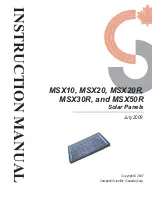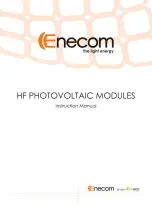
is lowest over the horizon.
5. MODULE TILT ANGLE
KD
xxxGX-LPU
series modules produce bigger power
when they are pointed directly at the sun.
For grid tie installations where the PV modules are attached
to a permanent structure, PV modules should be tilted at an
angle equal to the site's latitude. This will typically result in
the highest annual energy output.
6. INSTALLING KDxxxGX-LPU SERIES
MODULES
To install the module, use bolt and nut on installation holes
which are opened in the module frame and install the
module by following the instruction below.
The minimum spacing of .6” (15 mm) is required between
PV module and the mounting surface around the perimeter
of PV module.
KDxxxGX-LPU
series modules may be
installed in various applications utilizing a variety of support
structure options and attachment methods.
For optimal
performance in all applications, clearance between the
module frame and the mounting surface is required to allow
cooler ambient air to circulate around the back of the
module
and to avoid the module and / or wiring damage. A
minimum of .13” (3.2 mm) spacing must also be maintained
between module frames to allow for thermal expansion.
KDxxxGX-LPU
series modules may be attached to a
support structure by the following methods. When installing
modules in snowy area, an appropriate countermeasure
has to be taken to prevent possible damages to the lower
side frame by slipping snow (e.g. attach supporting parts to
the lowest modules.). Any damage caused by snow or such
countermeasure is not covered under warranty.
BOLTING
: Utilizing 5/16” or 8 mm steel hardware structure
through the existing .35” (9 mm) diameter mounting holes in
the module frame and then through
KDxxxGX-LPU
series
module mounting holes on the support structure. Tighten
the screws with adequate torque (usually 132 in-lb).
Support structure should have enough strength to keep the
mounting span. Refer to the Module Drawings for the
position of PV module mounting holes.
7. MODULE WIRING
KDxxxGX-LPU
series modules come pre-wired with
terminals ready for most building attachments or free
standing installations. Each module has two #12 AWG type
USE-2/RHH/RHW-2 stranded sunlight resistant output
cables each terminated with Multi-Contact
locking
connectors. The positive (+) terminal has a male connector
while the negative (-) terminal has a female connector. The
module wiring is solely for series connections only, i.e. male
(+) to female (-) interconnections. Series and parallel
connections shall be made by use of two #10-14 AWG type
XLPE sunlight resistant output cables with male and female
Multi-Contact
locking connectors.
NOTE
: When making connections with Multi-Contact
connectors, make sure the array is disabled.
DO NOT
MAKE CONNECTIONS WHILE UNDER LOAD
.
Module
output connections are marked “Do not disconnect under
load”.
NOTE: MAXIMUM SYSTEM VOLTAGE 600 VDC.
KDxxxGX-LPU
series modules and most PV system
components have a maximum system voltage rating of 600
volts DC. Some grid feed in systems operate at or near this
voltage rating. Like other polycrystalline the PV modules,
the open circuit voltage of the
KDxxxGX-LPU
series
modules increases as the ambient temperature decreases.
Maximum system voltage is computed as the sum of the
open-circuit voltage of the series-connected PV modules for
the lowest expected ambient temperature. Refer to the
National Electrical Code Article 690-7(a) for determining the
maximum number of
KDxxxGX-LPU
series modules that
can be placed
in series. Temperature coefficients, specific
to the module of use, can be used to provide the most
accurate prediction of module voltage under temperature
extremes.
NOTE: Install the maximum number of series connection for
the
KDxxxGX-LPU
series modules so that the system
voltage is less than 600 V.
NOTE: Do not connect the modules in parallel without
maximum over current protection.
NOTE: The minimum diameter that the cable can be bent
for the
KDxxxGX-LPU
series modules is 1.93” (49mm).
NOTE: In normal conditions, PV modules may produce
larger current and / or voltage than reported in the standard
test conditions. Therefore, when voltage evaluations for
components, capacity of conductors, size of fuses, and size
of control systems connected to the module output are
determined, multiply the values of short- circuit current (Isc)
and open-circuit voltage (Voc) that are marked in
KDxxxGX-LPU
series modules by the coefficient, 1.25.
8. GROUNDING
Before installation, contact the local code authorities to
determine the necessary grounding requirements. When
installing in US market, attach all PV module frames to an
earth ground in accordance with the National Electrical
Code (NEC) Article 250. Proper grounding is achieved by
connecting PV module frames and all metallic structural
members contiguously to one another using a suitable
grounding conductor. The grounding conductor shall be of
copper, copper alloy or another material suitable for use as
an electrical conductor per NEC. The grounding conductor
must then make a connection to earth using a suitable earth
grounding electrode. Ensure positive electrical contact
through the anodizing on the module frame extrusion by
utilizing one of the following methods. Attach the grounding
conductor:
(1)to one of the .35” (9mm) diameter holes marked “ground”
using 5/16” stainless steel hardware. Wrap conductor
around bolt. Tighten the screws with adequate torque
(usually 132 in-lb). Avoid direct contact of copper ground
conductor to aluminum frame.
(2)to a ground lug (manufacturer:ILSCO,model:GBL-4DBT).
Tighten the screws with adequate torque (usually 62
in-lb). Use #10-32 stainless steel hardware to attach the
lug to the module frame by the torque of 40 in-lb. A
stainless steel star washer, positioned between the lug
and the anodized surface of the frame, must be employed
to break through the anodized layer of the frame
extrusion and electrically connect the ground lug to the
conducting aluminum frame material.






















